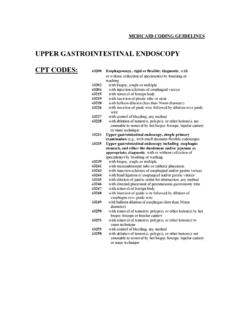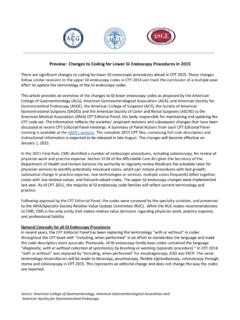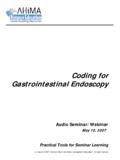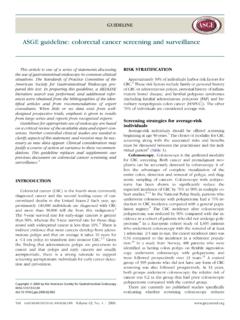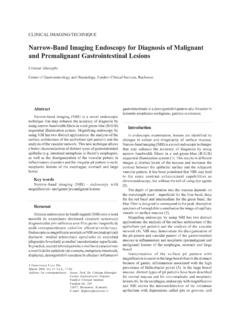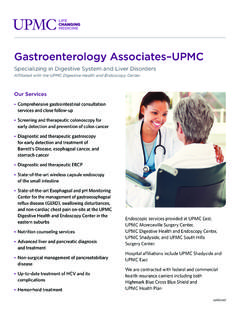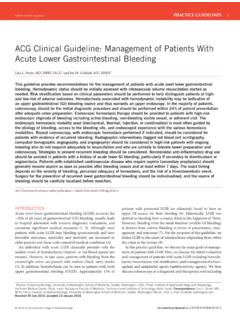Transcription of TEST QUESTIONS – GASTROINTESTINAL BLEEDING
1 -1- TEST QUESTIONS GASTROINTESTINAL BLEEDING question 1. The most frequent cause of UGI BLEEDING is: A. Esophageal varices B. Peptic ulcer disease C. Angiomata D. Mallory Weiss tear E. Gastritis The recommended response is B. Peptic ulcer disease is the most common cause of UGI BLEEDING , accounting for about 50% of cases. Other etiologies are far less common. For example, in one series the final diagnosis in 935 consecutive patients admitted with severe UGI hemorrhage was peptic ulcers in 57%, esophageal or gastric varices in 12%, UGI angiomas in 5%, Mallory Weiss tears in 5%, and gastric or duodenal erosion in 4%. Kovacs TOG, Jensen DM. Complications of peptic ulcer disease in GASTROINTESTINAL Disease: An Endoscopic Approach. Dimarino Jr. AJ,Benjamin SB, Eds. Slack Thorofare NJ.
2 Pp 411-438. 2002. -2- question 2. After initial stabilization and resuscitation of the patient, each of the following options should be considered in the management of UGI BLEEDING except: A. Determine the source of BLEEDING B. Stop acute BLEEDING C. Treat the underlying abnormality D. Prevent rebleeding E. Emergency surgery. The recommended response is E. After a patient with UGI hemorrhage is stabilized, each of the above statements is an appropriate therapeutic goal in the management of UGI BLEEDING except answer E. Surgery becomes a therapeutic option for patients with severe UGI hemorrhage if endoscopic hemostasis fails or if there is severe recurrent hemorrhage. -3- question 3. Endotracheal intubation for airway protection in the management of UGI BLEEDING should be considered: A.
3 In all cirrhotic patients B. in all patients with UGI BLEEDING C. in patients with altered mental status and ongoing hematemesis D. in patients with stable COPD E. unless it delays urgent endoscopy The recommended response is C. Airway protection in critical and aspiration is a preventable potential complication that markedly increases the morbidity and mortality associated with UGI BLEEDING . Cirrhotic patients may have altered mental status related to encephalopathy, but not all cirrhotics with UGI BLEEDING require intubation. Altered mental status and ongoing hematemesis are known risk factors for aspiration, and C is the best option. Stable COPD patients with a mild bleed and normal mental status do not require intubation. Similarly, not all UGI bleed patients need to be intubated for airway protection.
4 -4- question 4. A 73 year old man presents with several episodes of hematemesis. Examination shows signs of orthostatic hypotension and melena. What is the first priority in caring for this patient? A. Nasogastric tube placement and gastric lavage. B. Resuscitation with adequate IV access and appropriate fluid and blood product fusion. C. Intravenous infusion of H2-receptor antagonists to stop the BLEEDING . D. Urgent upper panendoscopy. E. Urgent surgical consultation. The recommended response is B. In the setting of an UGI bleed, features of orthostatic hypotension should be corrected immediately and resuscitation instituted concurrently with the initial evaluation. IV access should be adequate and appropriate fluid and blood products should be given. Only then should other aspects of the evaluation and care proceed with NG lavage, upper panendoscopy and surgical consultation.
5 IV H2-receptor antagonists have not been shown to stop BLEEDING or reduce rebleeding. Kovacs TOG, Jensen DM. Complications of peptic ulcer disease in GASTROINTESTINAL Disease: An Endoscopic TOG. Mallory-Weiss Tears, Angiodysplasia, Watermelon Stomach, and Dieulafoy s: A Potpourri. Techniques in GASTROINTESTINAL Endoscopy. 2005;7:139-147. Dimarino Jr. AJ,Benjamin SB, Eds. Slack Thorofare NJ. Pp 411-438. 2002. -5- question 5. An important risk factor for peptic ulcer hemorrhage includes: A. Gastric acid hypersecretion B. Corticosteroid use C. Cigarette smoking D. Non-sterioidal anti-inflammatory drug use E. Ethanol consumption The recommended response is D. NSAID ingestion has been clearly linked to peptic ulcer BLEEDING (Choice D). In CURE studies aspirin or NSAID ingestion within two weeks of ulcer hemorrhage was identified as the main risk factor in 53% of duodenal ulcers and 61% gastric ulcer patients.
6 Gastric acid hypersecretion is not essential for ulcer hemorrhage. No significant differences in secretory parameters such as basal, peak, or meal-stimulated acid output and parietal cell sensitivity, have been noted among ulcer patients with and without BLEEDING . Corticosteroid use alone is not associated with an increased frequency of ulcer hemorrhage. However, concomitant steroid use with NSAIDs increases the chance of UGI BLEEDING by 10-fold compared to NSAID use alone. Neither cigarette smoking nor ethanol consumption are associated with increased ulcer hemorrhage. Kovacs TOG, Jensen DM. Complications of peptic ulcer disease in GASTROINTESTINAL Disease: An Endoscopic TA, Logan RF, Devlin HB, et al. Risk management after acute upper GASTROINTESTINAL hemorrhage.
7 GUT 1996;38:316-321. Dimarino Jr. AJ,Benjamin SB, Eds. Slack Thorofare NJ. Pp 411-438. 2002. -6- question 6. Which of the following combinations of stigmata of ulcer hemorrhage should be treated with endoscopic hemostasis? A. Non- BLEEDING visible vessel and black slough B. Pulsatile BLEEDING and white based ulcer C. Oozing from an ulcer and a flat red spot D. Non- BLEEDING visible vessel and pulsatile BLEEDING E. Black slough and white based ulcer The recommended response is D. The endoscopic finding of active hemorrhage from an ulcer, either pulsatile or spurting BLEEDING is an indication for treatment (Choice D). Finding a visible vessel, also called a sentinel clot or pigmented protuberance, is another indication for endoscopic coagulation since there is a 50% chance of rebleeding.
8 Flat red spots and black slough are minor stigmata of hemorrhage and have about a 7% risk of rebleeding. Patients with a clean ulcer base have a 3% or less chance of rebleeding. Khuroo MS, Yattoo GN, Javid G, et al. A comparison of omeprazole and placebo for BLEEDING peptic ulcers. N Engl J Med 1997;336:1054-1058. Lai J, Sung J, Leek at el. Effect of intravenous omeprazole and placebo for BLEEDING peptic ulcer. N Engl J Med 2000; 343:310-316. Bardou M, Toubouti Y, Benhaberou-Brown D, et al. Meta-analysis: proton pump inhibition in high-risk patients with acute peptic ulcer BLEEDING . Aliment Pharmacol Ther. 2005;21:677-686. -7- Rockall TA, Logan RF, Devlin HB, et al. Risk management after acute upper GASTROINTESTINAL hemorrhage. GUT 1996;38:316-321.
9 Kovacs TOG, Jensen DM. Complications of peptic ulcer disease in GASTROINTESTINAL Disease: An Endoscopic Approach. Dimarino Jr. AJ,Benjamin SB, Eds. Slack Thorofare NJ. Pp 411-438. 2002. -8- question 7. For the patient who is now stable after a severe UGI bleed associated with NSAID ingestion, and who is found to be positive, what is the most effective management strategy? A. Stop NSAIDS, eradicate , H2RA full dose or daily PPI maintenance therapy B. Stop NSAIDs, full dose H2RA or daily PPI maintenance therapy C. Stop NSAIDs D. Eradicate , full dose H2RA or daily PPI maintenance therapy F. Full dose H2-receptor antagonist or daily PPI maintenance therapy The recommended response is A. Since the UGI bleed was associated with NSAID ingestion, these agents should be discontinued if the underlying medical condition allows.
10 Further, since the patient is positive, eradication therapy should be initiated. Since eradication may not be completely effective and since patients often reuse NSAIDs, full dose H2-receptor antagonist or daily PPI maintenance therapy would provide the most complete protection against recurrent ulcer hemorrhage, at least until the effect of eradication can be checked with follow-up urea breath testing or endoscopy. Kovacs TOG, Jensen DM. Complications of peptic ulcer disease in GASTROINTESTINAL Disease: An Endoscopic Approach. Dimarino Jr. AJ,Benjamin SB, Eds. Slack Thorofare NJ. Pp 411-438. 2002. -9- Kahi CJ, Jensen DM, Sung JJ, et al. Endoscopic therapy versus medical therapy for BLEEDING peptic ulcer with adherent clot: a meta-analysis. Gastroenterology. 2005;129:855-62.
